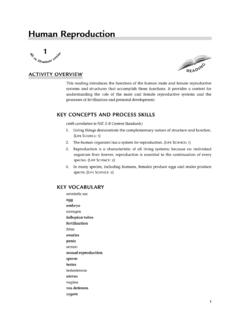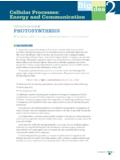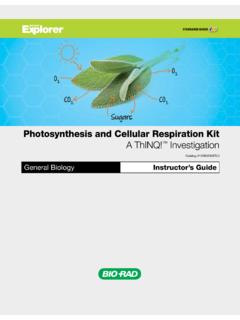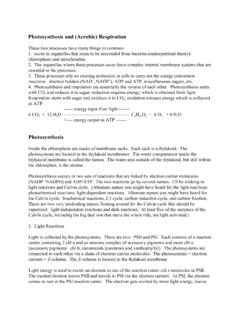Transcription of The Photosynthesis and Cellular Respiration Shuffle
1 158 9 The Photosynthesis and Cellular Respiration ShuffleoveR viewIn this activity, students investigate Photosynthesis and cel-lular Respiration by organizing a series of images and state-ments and connecting this information to the carbon cycle. The activity includes an optional demonstration on making ginger ale to demonstrate fermentation, which will be referred to over the course of several content 1. Photosynthesis is a Cellular process through which organisms capture light energy from the sun and use it to generate and store energy. 2. Cellular Respiration releases stored energy in glucose, allowing the organism to function. 3. Light is required for Photosynthesis to occur, although parts of Photosynthesis can happen in the absence of light. 4. Photosynthesis happens in the chloroplasts, which con-tain chlorophyll. 5. only producers can perform Photosynthesis .
2 6. Cellular Respiration happens in the mitochondria and cytoplasm of cells. 7. many organisms, including plants and plankton, per-form oxygen-dependent Cellular Respiration . 8. Photosynthesis takes in light energy, carbon dioxide, and water, producing glucose and oxygen. 9. Cellular Respiration takes in oxygen and glucose and pro-duces carbon dioxide and water. adenosine triphosphate (aTp) is also produced from Cellular Respiration . 10. The substances produced and consumed in photosyn-thesis and Cellular Respiration are PRocess sKills 1. Students develop conclusions based on evidence. 2. Students make accurate interpretations, inferences, and conclusions from and advance PRePaRationFor the teacher Transparency , Kelp Forest Food Web Transparency , carbon cycle Scoring Guide: unDERSTanDInG concEpTS (uc) overhead markers* 2-liter plastic soda bottle with cap (optional)* funnel, for food use only (optional)* grater, for food use only (optional)* 1-cup measuring cup, for food use only (optional)* -tsp measuring spoon, for food use only (optional)* 1-tbs measuring spoon, for food use only (optional)* 1 cup sugar (optional)* 1 2 tbs fresh ginger root (optional)* 1 lemon (optional)* tsp fresh granular baker s yeast (optional)* cold water (optional)*For each group of four students set of 12 Photosynthesis & Cellular Respiration Shuffle paper stripsFor each pair of students computer with Internet access*For each student Student Sheet , Photosynthesis and Cellular Respiration Diagram Group Interaction Student Sheet 2, Developing communication Skills (optional) Scoring Guide.
3 UnDERSTanDInG concEpTS (uc) (optional)*Not supplied in kitinvestigation 1 2 c l a s s s e s s i o n s159the Photosynthesis and Cellular Respiration Shuffle a ctivity 9If you plan to demonstrate making ginger ale, prepare the for Scoring Guides are in Teacher Resources IV: Assessment. Note: Arrange for computers with Internet access for the day(s) students do this activity. Go to the Science and Global Issues page of the SEPUP website to access the simulation. You may want to bookmark this site for students. Make sure the browsers and supporting software are current and can properly run the simulation. If internet access is not available, Photosynthesis and Cellular Respiration cards are provided in the kit. Provide appropriate instructions for students, based on the suMMaRyGetting Started The class makes predictions about Cellular Respiration and the Activity (uc aSSESSmEnT) Students investigate and compare cel-lular Respiration and photosynthesisFollow-up (uc aSSESSmEnT) Review the connections between the carbon cycle, Photosynthesis , and Cellular gR ound infoRMationIn this unit, students learn about the most familiar type of Cellular Respiration , which is oxygen-dependent (aerobic) and occurs in many organisms such as macroscopic organ-isms, as well as microscopic plankton and other microbes.
4 In general, Cellular Respiration is the metabolic process that releases stored chemical energy to make it available for cells to use. all organisms conduct some form of Cellular respira-tion, but not all organisms require oxygen to do so. many bacteria and archaea are lithotrophs, as opposed to organo-trophs, meaning they rely on such inorganic materials as metal ions and sulfur as electron receptors for Cellular respi-ration, instead of oxygen. other organisms do not need the electron-transport chain; for example, yeast can obtain aTp strictly through fermentation without the electron-transport chain. additionally, it is important to note that many organ-isms obtain oxygen without breathing. For example, many insects rely on diffusion to obtain intracellular oxygen. Cellular Respiration and Photosynthesis have a direct link to ecosystem sustainability. Ecosystem collapse often begins with the removal of one or more species, which ultimately disturbs the balance between the carbon-containing com-pounds needed for Cellular Respiration and Photosynthesis .
5 As those two processes depend on each other, if the balance is disturbed long-term or permanently, the ecosystem is no longer sustainable. It is possible that another organism could fill the role of the species that was removed, but this often comes with a cascade of adverse side effects, such as happens with the invasive species that were studied in activity 4, Invasive Species. 160science and global issues/biology ecologygetting staR ted 1 Note: Cellular Respiration and Photosynthesis are treated in more detail in the cell Biology: World Health unit of this course. project Transparency , Kelp Forest Food Web. Explain to stu-dents that this is a sample answer for the food webs they created in activity 7, Energy Flow Through an Ecosystem. point out that this is one way to portray the food web, but not the only correct way. There are many possible versions, as they saw in activity 7.
6 Project Trans-parency , carbon cycle. Have students identify where in the carbon cycle producers and con-sumers play a role. 2 after students read the introduc-tion, ask them to predict where pho-tosynthesis would occur in the kelp forest ecosystem, shown in Trans-parency , Kelp Forest Food Web. as students offer answers, use an overhead marker to mark the organisms that perform photosyn-thesis (phytoplankton, giant kelp, acid kelp, and cyanobacteria). at this point students may not name all of these organisms. Because the class will revisit this diagram at the end of the activity, it is not necessary that they mark each organism or that you correct any incomplete or inaccurate answers. Then have students predict where in the kelp forest ecosystem Cellular Respiration would occur. mark these organisms using a marker of another color. Show students the video clip Energy Flow in the coral Reef Ecosystem, the link to which is on the Science and Global Issues page of the SEpup website ( ).
7 Dis-cuss how the energy flow in this ecosystem parallels that in the kelp forest ecosystem. 3 Have students work on Student Sheet , photo-synthesis and Cellular Respiration Diagram, in pencil, as they will be changing the diagram over the next few activities. Tell them to label the paths they think oxygen, glucose, carbon dioxide, and water take through the eco-system. Students should make their best guess if they are unsure. Their diagrams will vary, and may not be accu-rate at this point. The purpose of the diagram is to allow them to revisit their ideas, learning, and misconceptions about Photosynthesis and Cellular Respiration throughout this sequence of activities. This is a formative assessment opportunity for you to determine your students current understanding of Photosynthesis and Cellular Respiration . There will be opportunities to address errors and miscon-ceptions later on in this 9 The Photosynthesis and Cellular Respiration Shuffl eIN THE PREVIOUS activity, Moving Through the Carbon Cycle, you examined how carbon travels between reservoirs on earth.
8 In this activity you will look hbl bihhii iill lkmore closely at how carbon and oxygen are continuously cycled by organisms and how these elements sustain both theorganisms and ecosystems. You will examine what happens to carbon andoxygen at the Cellular level. Two fundamental Cellular processes are Cellular Respiration and Respiration is the process by which cells release stored energy from isthe process in which producer cells use carbon dioxide, water, and nutrients toproduce glucose and oxygen. Together these two processes make the carboncycle possible, and move essential mol-ecules through How do carbon and oxygen cycle through the environment? MATERIALSFOR EACH GROUP OF FOUR STUDENTSFOR EACH GROUP OF FOUR STUDENTS set of 12 Photosynthesis and Cellular Respiration Shuffle paper stripsyppp pFOR EACH PAIR OF STUDENTSFOR EACH PAIR OF STUDENTS computer with Internet accesspFOR EACH STUDENTFOR EACH STUDENT Student Sheet , Photosynthesis and Cellular Respiration Diagram ,yp gAll organisms in this community perform Cellular Respiration and some and change a ctivity 1the Photosynthesis and Cellular Respiration Shuffle a ctivity 9161If you intend to demonstrate fer - men tation (an optional component of this activity), set up a ginger ale mixture to ferment over the next several days.
9 See the link on SEpup s Science and Global Issues website ( ) for detailed instructions. doing the activity 4 The simulation is on the Science and Global Issues website ( ). as students work through the simulation, encourage them to look closely at the dia-grams. In particular, they should note the directions of arrows, indi-cating if materials are entering or leaving an organism. In the photo-synthesis diagrams, for example, water will be shown as entering an organism, while in Cellular respira-tion it will be leaving the organism. This is a good opportunity for stu-dents to work on their communica-tion skills by discussing with their partners the details of the diagrams and what they mean. you may wish to use Group Interaction Student Sheet 2, Developing communica-tion Skills, which gives students suggestions for communicating well when in a group. once they have completed the simula-tion students might print a screen shot so that they have a record for their student notebooks of the information from the simulation.
10 5 (uc aSSESSmEnT) If students need assistance in ordering the paper strips, encourage them to look for clues within the statements. For example, any statement that contains the word producers would go in the Photosynthesis stack. you also may want to tell the students that some of the steps essentially happen simultaneously, so their order is interchangeable. For example, Sunlight hits the green parts .. and producer takes in carbon dioxide .. could be in reverse order and still be correct orders for the strips are as follows: Photosynthesis : K, G, J, D, B, I (steps K and G can be reversed) Cellular Respiration : E, A, F, C, L, H (steps c, L, and H are interchangeable) 6 Students written summaries should be brief a short paragraph for each process. Encourage students to put the process into their own words as much as possible. proce-dure Steps 5 11 are an opportunity for a uc aSSESSmEnT using the unDERSTanDInG concEpTS Scoring Photosynthesis AND Cellular Respiration Shuffle ACTIVITY 9 Procedure1.
















